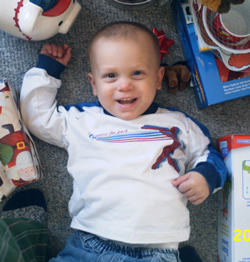Miracle Kids: Anders Swanson
Youngster Fights Tumor with Grace
 In January 2007, 18-month-old Anders Swanson was running up and down Florida shores with his parents, Amy and Garth. It would be the last family vacation before his little brother, Beckett, would be born in mid-spring.
In January 2007, 18-month-old Anders Swanson was running up and down Florida shores with his parents, Amy and Garth. It would be the last family vacation before his little brother, Beckett, would be born in mid-spring.
After returning home to Batavia, Amy became aware that something was wrong with young Anders. What had seemed like airsickness—he was vomiting on the plane—didn’t ease up when they touched down. And as the month drew on, Anders began shaking and stumbling.
On a Saturday in February, on a hunch, Amy drove Anders to the children’s hospital, where doctors ran a battery of tests and came back to Amy with news she never expected: There was a mass in his brain, and they were admitting him immediately.
Later that night, Anders started anti-seizure medications and steroids to help relieve the hydrocephalus, or excess fluid that was putting pressure on his brain. After a biopsy and spinal tap, the Swansons sat down with David Korones, M.D., and Howard Silberstein, M.D.—pediatric oncologist and pediatric neurosurgeon at Golisano Children’s Hospital, respectively—for the first of many heart-to-hearts.
Anders had a rare, aggressive brain tumor near the center of his brain, Korones told the Swansons. Called pineoblastoma, the mass was the size of a large gumball.
“They were very honest with us,” Garth said. “Most childhood cancers are curable, but this one would be an uphill battle.”
Korones began poring over research publications and tapping colleagues nationwide to synthesize a treatment plan just for Anders: first, a few rounds of intensive chemotherapy to tackle the cancer cells in his brain and spinal fluid; then, radiation to shrink the tumor itself and surgery to remove it; and finally, two more sessions of strong chemotherapy, this time, paired with a technique called “stem cell rescue” (Anders’ own blood stem cells, harvested at the beginning of treatment, would strengthen him later on).
A week after his biopsy, Anders was discharged home to rest up, but he was only home a day before fever struck—rotavirus, a staph infection, and thrush brought a triple-threat, landing him back in the hospital for a 6-week stay, during which he began treatment.
“It was really rocky. He’s a powerhouse of a kid, but suddenly he was only wanting to be held, too sick to even eat. He fell from 27 pounds to 20; at points he was even fed intravenously,” Amy remembered.
Thankfully, the second and third rounds of chemotherapy went more smoothly. Soon, it came time for conformal radiation. This high-tech procedure uses computer simulation to construct an image of a tumor, then shapes beams to the exact contours of the treatment area, sparing healthy tissue and minimizing risk for long-term cognitive effects. Soon the tumor had shrunk enough so that, now 4 months along in his treatment plan, surgery had become feasible. Again, Anders came through with strength, and Silberstein was able to excavate at least 90 percent of the tumor. Days later, Amy delivered Beckett. Anders’ doctors came down to congratulate the Swansons on their second baby, and a few days later, the whole family was discharged together.
Anders’ treatment continued smoothly, finishing with final rounds of the chemotherapy, now with the “stem cell rescue” to give him extra vigor.
Finally, in mid-September 2007 —after a 7-month whirlwind of every cancer-blasting weapon imaginable—Anders was declared cancer-free. He is still being monitored on a fairly regular basis, but he continues to enjoy waking up in the wee morning hours to eat “beegles and wiffles” for breakfast. Every morning he looks forward to sending cell-phone videos back and forth to his Grandma and Umpa (Grandpa) in Florida.
In addition to his team at Strong, Anders is also receiving great care from his Rochester-based pediatrician, Molly Hughes, M.D., who works at Westside Pediatrics in Gates. Hughes has taken on an incredible advocacy role for Anders and his special health needs.
“Anders is a miracle—he’s the kind of kid that screams almost everything he says, just bursting with joy,” Korones said. “But I suppose it is in part genetic, because his parents are just as special.”